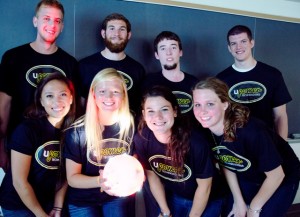Eight students representing four different majors came together to create a simulated startup company, UPower Technologies, integrating piezo-electric and light-emitting diode (LED) technologies into a recreational, educational, and rehabilitation device.

The UPower Technologies team with the GameGlowb
It’s a pilot effort for the type of design projects envisioned for Lafayette’s new Center for Innovation, Design, Entrepreneurship, and Leadership (IDEAL), which will support multidisciplinary learning, collaboration, and entrepreneurship.
“When thinking about our senior project, we knew we wanted to do something different,” says mechanical engineering major Ryan Kastner ’13. “We decided to try and build our own original product. Not only would we create a unique product, we would also get a chance to work with a multi-disciplinary team. That is, we as engineers would get a chance to work alongside art and econ majors as they would work on the design and market strategy of our product.”
Dayne Mosconi ’13, a mechanical engineering major, and Kastner focused on product development and prototyping. Mechanical engineering majors Kaitlynn Zoller ’13 and Jessica Rothstein ’13 led the team on material and manufacturing and market survey. The business plan, budget, and marketing plan were laid out by economics majors Derek Sigler ’13 and Victoria Ueland ’14. Leah Dungo ’13, a double major in American studies and film & media studies, focused on product design and advertising and Drew Jeffrey ’14, who is majoring in electrical and computer engineering, led the team when it came to electrical systems. Jess Comer, visiting assistant professor of mechanical engineering, served as adviser.
Used in various appliances today, a piezo-electric material is a ceramic type of material with a crystalline structure that produces an electric charge when it is physically deformed. LEDs are small structures that emit energy in the form of photons. They serve as a versatile lighting source with many color options.
“These two technologies work very well together,” explains Kastner. “Piezo gives off a small current and the LEDs only need a small input to light and thus work well with the piezo material. Coupled together, this technology offers an interactive product that gives visual feedback based on the amount of energy put into the piezo; the more the piezo beam is deflected, the brighter/more frequently the LEDs light up.”
The team created a game device called the GameGlowb. It works by using a piezo beam to generate a charge from human motion. The charge is stored in a capacitor and once the capacitor is full, it discharges, lighting red LEDs and sounding a buzzer.
“While a very basic idea, the GameGlowb is also very versatile,” Kastner says. “It can be used as a rehab device, or for workouts. The purpose of the device is to not only be a fun game, but also to demonstrate the potential uses for piezo technology in energy harvesting.”
Working with engineers was a new experience for Dungo, whose responsibilities included choosing the overall look of the product and designing the company logo and mock-beta website (http://upowertechnologies.wix.com/beta).
“As an American studies and film double major with an art minor, I was fortunate enough to take classes with students from a variety of different majors,” she says. “However, to work with engineers for this project was really cool because our studies don’t really ever cross so there was so much to learn from them and vice versa,” she says.

2 Comments
This product is really nice. I hope I could go to IDEAL center to see more about it!
Comments are closed.